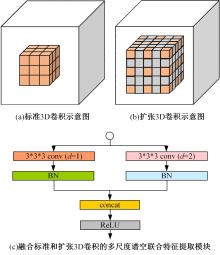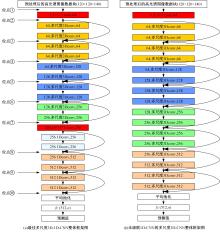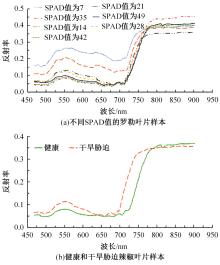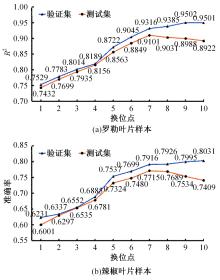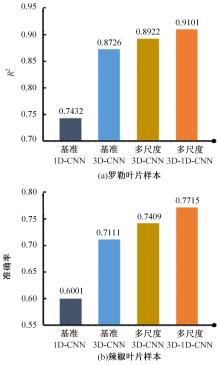Journal of Jilin University(Engineering and Technology Edition) ›› 2023, Vol. 53 ›› Issue (12): 3547-3557.doi: 10.13229/j.cnki.jdxbgxb.20220096
Analysis of hyperspectral image based on multi-scale cascaded convolutional neural network
Feng-le ZHU1( ),Yi LIU2,3,4,Xin QIAO1,Meng-zhu HE2,3,Zeng-wei ZHENG2,3,Lin SUN2,3(
),Yi LIU2,3,4,Xin QIAO1,Meng-zhu HE2,3,Zeng-wei ZHENG2,3,Lin SUN2,3( )
)
- 1.College of Mechanical Engineering,Zhejiang University of Technology,Hangzhou 310023,China
2.School of Computer & Computing Science,Hangzhou City University,Hangzhou 310015,China
3.Intelligent Plant Factory of Zhejiang Province Engineering Laboratory,Hangzhou 310015,China
4.College of Computer Science and Technology,Zhejiang University,Hangzhou 310027,China
CLC Number:
- S24
| 1 | Yu Ke-qiang, Zhao Yan-ru, Zhu Feng-le, et al. Mapping of chlorophyll and SPAD distribution in pepper leaves during leaf senescence using visible and near-infrared hyperspectral imaging[J]. Transactions of the ASABE, 2016, 59(1): 13-24. |
| 2 | Zhang Chu, Wu Wen-yan, Zhou Lei, et al. Developing deep learning based regression approaches for determination of chemical compositions in dry black goji berries (Lycium ruthenicum Murr.) using near-infrared hyperspectral imaging[J]. Food Chemistry, 2020, 319: No. 126536. |
| 3 | Hadji I, Wildes R P. What do we understand about convolutional networks?[J/OL]. [2022-01-02]. |
| 4 | Zhu Su-su, Zhou Lei, Gao Pan, et al. Near-infrared hyperspectral imaging combined with deep learning to identify cotton seed varieties[J]. Molecules, 2019, 24: No. 3268. |
| 5 | Yang Wei, Yang Ce, Hao Zi-yuan, et al. Diagnosis of plant cold damage based on hyperspectral imaging and convolutional neural network[J]. IEEE Access, 2019, 7: 118239-118248. |
| 6 | Rehman T U, Ma D, Wang L, et al. Predictive spectral analysis using an end-to-end deep model from hyperspectral images for high-throughput plant phenotyping[J]. Computers and Electronics in Agriculture, 2020, 177: No. 105713. |
| 7 | He Wei-wen, He Hong-yuan, Wang Fang-lin, et al. Non-Destructive detection and recognition of pesticide residues on garlic chive (Allium Tuberosum) leaves based on short wave infrared hyperspectral imaging and one-dimensional convolutional neural network[J]. Journal of Food Measurement and Characterization, 2021, 15: 4497-4507. |
| 8 | Park K, Hong Y K, Kim G H, et al. Classification of apple leaf conditions in hyper-spectral images for diagnosis of Marssonina blotch using mRMR and deep neural network[J]. Computers and Electronics in Agriculture, 2018, 148: 179-187. |
| 9 | Zhang Jin-nuo, Yang Yong, Feng Xu-ping, et al. Identification of bacterial blight resistant rice seeds using terahertz imaging and hyperspectral imaging combined with convolutional neural network[J]. Frontiers in Plant Science, 2020, 11: No.821. |
| 10 | Polder G, Blok P M, de Villiers H A C, et al. Potato virus Y detection in seed potatoes using deep learning on hyperspectral images[J]. Frontiers in Plant Science, 2019, 10: No.209. |
| 11 | Pang Lei, Sen Men, Yan Lei, et al. Rapid vitality estimation and prediction of corn seeds based on spectra and images using deep learning and hyperspectral imaging techniques[J]. IEEE Access, 2020, 8: 123026-123036. |
| 12 | Nagasubramanian K, Jones S, Singh A K, et al. Plant disease identification using explainable 3D deep learning on hyperspectral images[J]. Plant Methods, 2019, 15: No. 98. |
| 13 | Yan Tian-ying, Xu Wei, Lin Jiao, et al. Combining multi-dimensional convolutional neural network (CNN) with visualization method for detection of Aphis gossypii glover infection in cotton leaves using hyperspectral imaging[J]. Frontiers in Plant Science, 2021, 12: No. 604510. |
| 14 | Kamilaris A, Prenafeta-Boldú F X. Deep learning in agriculture: a survey[J]. Computers and Electronics in Agriculture, 2018, 147: 70-90. |
| 15 | Hara K, Kataoka H, Satoh Y. Can spatiotemporal 3D CNNs retrace the history of 2D CNNs and ImageNet?[C]∥Proceedings of the IEEE Conference on Computer Vision and Pattern Recognition, Salt Lake City, UT, USA, 2018: 6546-6555. |
| 16 | Roy S K, Krishna G, Dubey S R, et al. HybridSN: exploring 3-D-2-D CNN feature hierarchy for hyperspectral image classification[J]. IEEE Geoscience and Remote Sensing Letters, 2020, 17(2): 277-281. |
| 17 | 张祥东, 王腾军, 朱劭俊, 等. 基于扩张卷积注意力神经网络的高光谱图像分类[J]. 光学学报, 2021, 41(3): 43-53. |
| Zhang Xiang-dong, Wang Teng-jun, Zhu Shao-jun, et al. Hyperspectral image classification based on dilated convolutional attention neural network[J]. Acta Optica Sinica, 2021, 41(3): 43-53. | |
| 18 | 李运丽. 光强对罗勒叶中花青素含量及光合特性的影响[D]. 南京: 南京农业大学园艺学院, 2011. |
| Li Yun-li. Effects of light intensity on anthocyanins contents and photosynthetic characteristics in Ocimum basilicum L . leaves[D]. Nanjing: College of Horticulture, Nanjing Agricultural University, 2011. | |
| 19 | 张德炎. 水分胁迫对辣椒叶片生理活性的影响[J]. 湖北农业科学, 2010, 49(4): 819-821. |
| Zhang De-yan. Effect of water stress on some physiology indices of pepper leaves[J]. Hubei Agricultural Sciences, 2010, 49(4): 819-821. | |
| 20 | Tran D, Bourdev L, Fergus R, et al. Learning spatiotemporal features with 3D convolutional networks[C]∥Proceedings of the IEEE International Conference on Computer Vision, Santiago, Chile, 2015: 4489-4497. |
| 21 | Yu F, Koltun V. Multi-scale context aggregation by dilated convolutions[J/OL]. [2022-01-05]. |
| 22 | He Kai-ming, Zhang Xiang-yu, Ren Shao-qing, et al. Deep residual learning for image recognition[C]∥Proceedings of the IEEE Conference on Computer Vision and Pattern Recognition, Las Vegas, NV, USA, 2016: 770-778. |
| 23 | Cruz A, Ampatzidis Y, Pierro R, et al. Detection of grapevine yellows symptoms in Vitis vinifera L. with artificial intelligence[J]. Computers and Electronics in Agriculture, 2019, 157: 63-76. |
| 24 | Ollinger S V. Sources of variability in canopy reflectance and the convergent properties of plants[J]. New Phytologist, 2011, 189: 375-394. |
| 25 | 蔡倩, 白伟, 郑家明, 等. 水分胁迫对春玉米光合特性及水分利用效率的影响[J]. 辽宁农业科学, 2021, 5: 1-6. |
| Cai Qian, Bai Wei, Zheng Jia-ming, et al. Effect of water stress on photosynthetic characteristics and water use efficiency of spring maize[J]. Liaoning Agricultural Sciences, 2021, 5: 1-6. | |
| 26 | 汤东, 程平, 杨建军, 等. 天山北坡山前植物对干旱胁迫的生理响应[J]. 干旱区研究, 2021, 38(6): 1683-1694. |
| Tang Dong, Cheng Ping, Yang Jian-jun, et al. Physiological responses of plants to drought stress in the Northern Piedmont, Tianshan Mountains[J]. Arid Zone Research, 2021, 38(6): 1683-1694. |
| [1] | Lin MAO,Feng-zhi REN,Da-wei YANG,Ru-bo ZHANG. Two⁃way feature pyramid network for panoptic segmentation [J]. Journal of Jilin University(Engineering and Technology Edition), 2022, 52(3): 657-665. |
| [2] | WANG Ke-yan, LI Yun-song, SONG Juan, LIAO Hui-lin, WU Xian-yun. Spatial-spectral lossless compression of hyperspectral images using local edge based prediction [J]. 吉林大学学报(工学版), 2017, 47(2): 677-685. |
|
||


